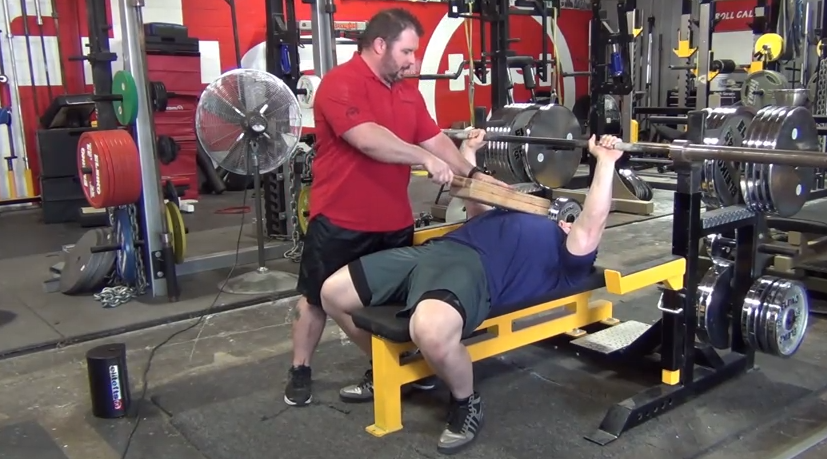
Elitefts™ Director of Education Mark Watts explains some minor technique adjustments when utilizing board pressing in a sports performance setting. Mountain Dog Diet™ and Elitefts™ intern Derek Dolgner demonstrates on the Elitefts™ Signature Bench.
Two Reasons Most Lifters use Boards
1.) Shirt Work
The first and most common reason for performing board presses is for a geared powerlifter to enhance his/ her ability to "touch weights". Being able to control a weight heavy enough to touch is a skill that needs progressed throughout a training cycle. Theoretically, as the weight increases progressively through training cycle, less boards can be used to increase the range of motion and decrease the distance the bar stops on the chest. Boards can provide added safety in the bench press and provide a standard and quantitative system of ROM.
2.) Decreased Range of Motion.
Using boards can also provide a a progressive system for post shoulder rehabilitation, athletes with an injury history, and/ or athletes in sports where shoulder care is at a premium (pitchers). Using boards for this may be overkill if the lifter is simply trying to standardize the range of motion. When performing a "touch & go" technique, the boards are there just to reduce the range of motion. A shoulder Saver Pad or Super Shoulder Saver bar may actually serve as a better apparatus.
Two Modifications that May Benefit More in an Athletic Setting
1.) Minimizing the Eccentric Contraction.
This is something I learned from John Bott back in 2005. One of the most overlooked advantages of implementing board presses in a program is the eccentric contraction can be minimized by letting the board descend quickly on the boards. This isn't exactly like a free-fall or flat-out dropping of the bar; the athlete still needs to stay tight in the upper back and lats. The reduction in the time-under-tension will have two distinct benefits
A.) Delayed Onset Muscle Soreness is often attributed to the eccentric contraction of any exercise. This is especially important for In-Season training.
B.) By reducing the eccentric contraction, the musculature responsible for pressing is less fatigued and essentially more motor units are available for the concentric contraction.
2.) Modifying the Amortization Phase
With the barbell resting on the board, the total time-under-tension is basically cut in half. Essentially, this is a similar concept to box-squatting in the fact that as the bar hits the board, less tension is placed on certain muscle groups. Again, the athletes should stay "tight" when the bar is semi-resting on the board. This separation in the eccentric-concentric chain forces the athlete to overcome inertia and can aid in developing explosive power. (Tate, Simmons).
The Board Press for Athletes Checklist
- Set up should be the same as Bench Press
- Stay tight and bring the bar down fast to the board
- Continue to stay tight by "pulling the bar into the board".
- "Launch" the bar off the board to extension.
What Boards to Use
For most athletes, a 2 or 3 board will be sufficient. As a general rule, the lowest board used should inhibit the athletes from lowering the bar too far past the point where the elbow joint is at 90 degrees.
Incorporating Board Presses into the Methods (examples)
- Circa-Max Effort: 2-Board Press for a 3-5RM
- Dynamic Effort: 3-Board Press with Chains w/ 60% for 6 sets of 3 & 45 sec RI
- Submax Effort: 1,2,3,4 Board Press for Max Reps & 20 sec RI
In-Season Board Press Progression
- Wk1.) 2 Board Press 5RM x 3, 2, 1, -10% x5
- Wk2.) 3 Board Press w/ Chains: 75%x3, 80%x3, 70%x3, 85%x3
- Wk3.) 2 & 3 Board Press Combo: 5RM x 4 (2 reps w/ 2B, 2 reps w/ 3B)
- Wk4.) 2 Board Press w/ Chains: 80%x3, 85%x3, 75%x3, 90%x3
- Wk5.) 3 Board Press: 5RM for 5 doubles
- Wk6.) 2 Board Press: 3RM x 3, 2, 1








